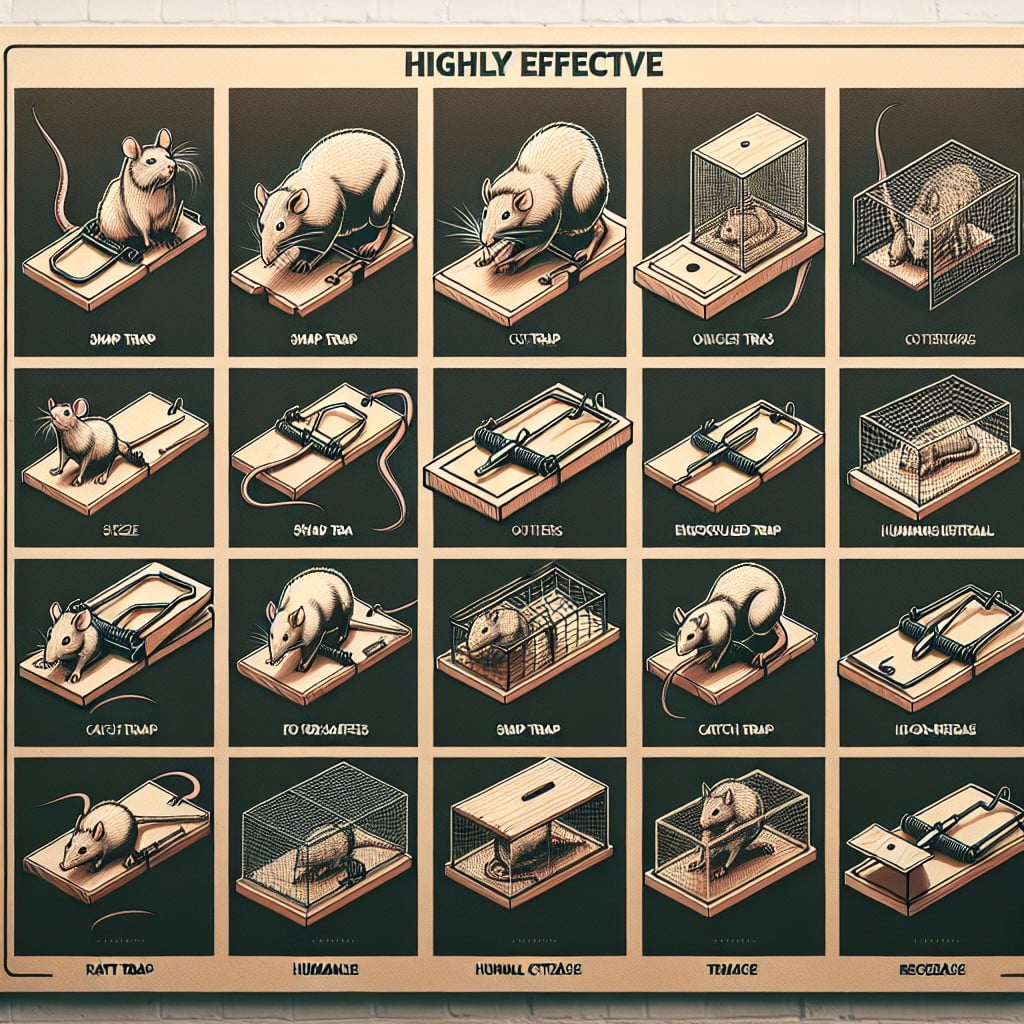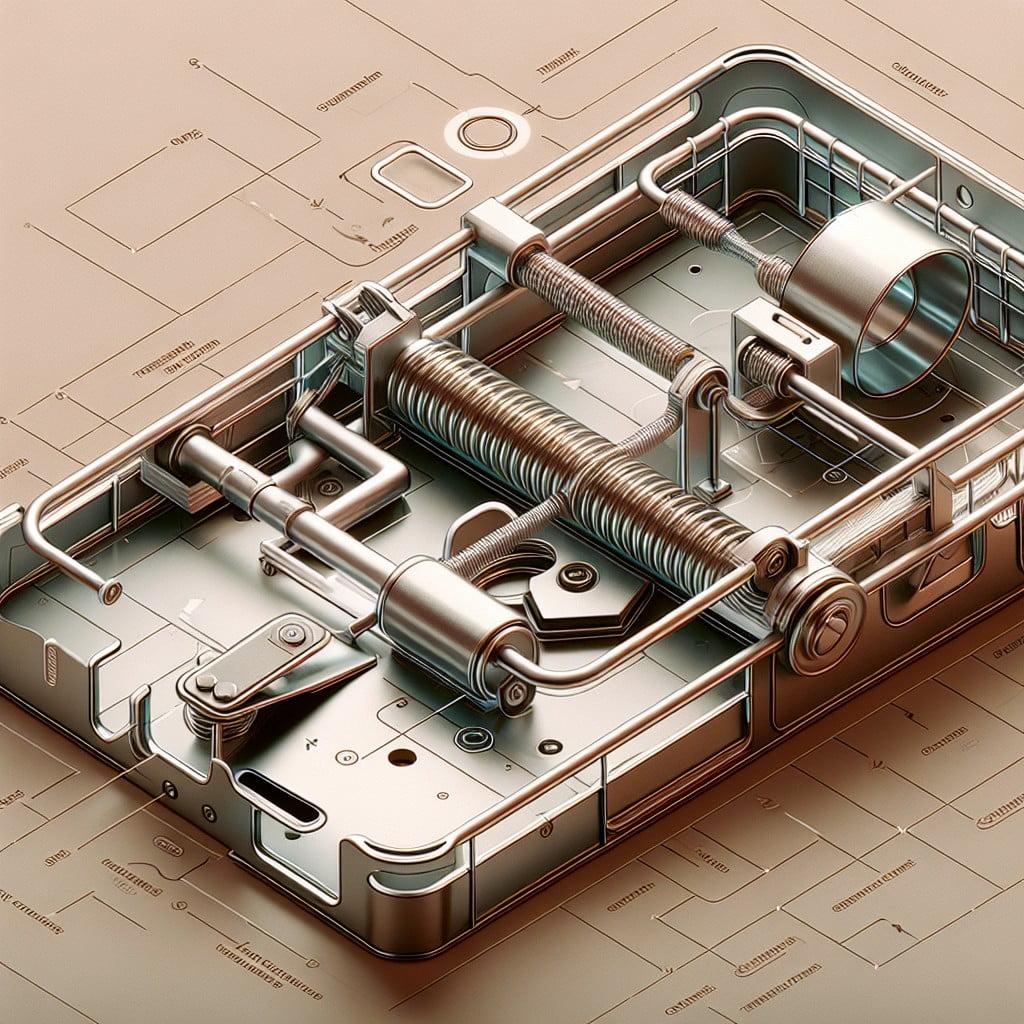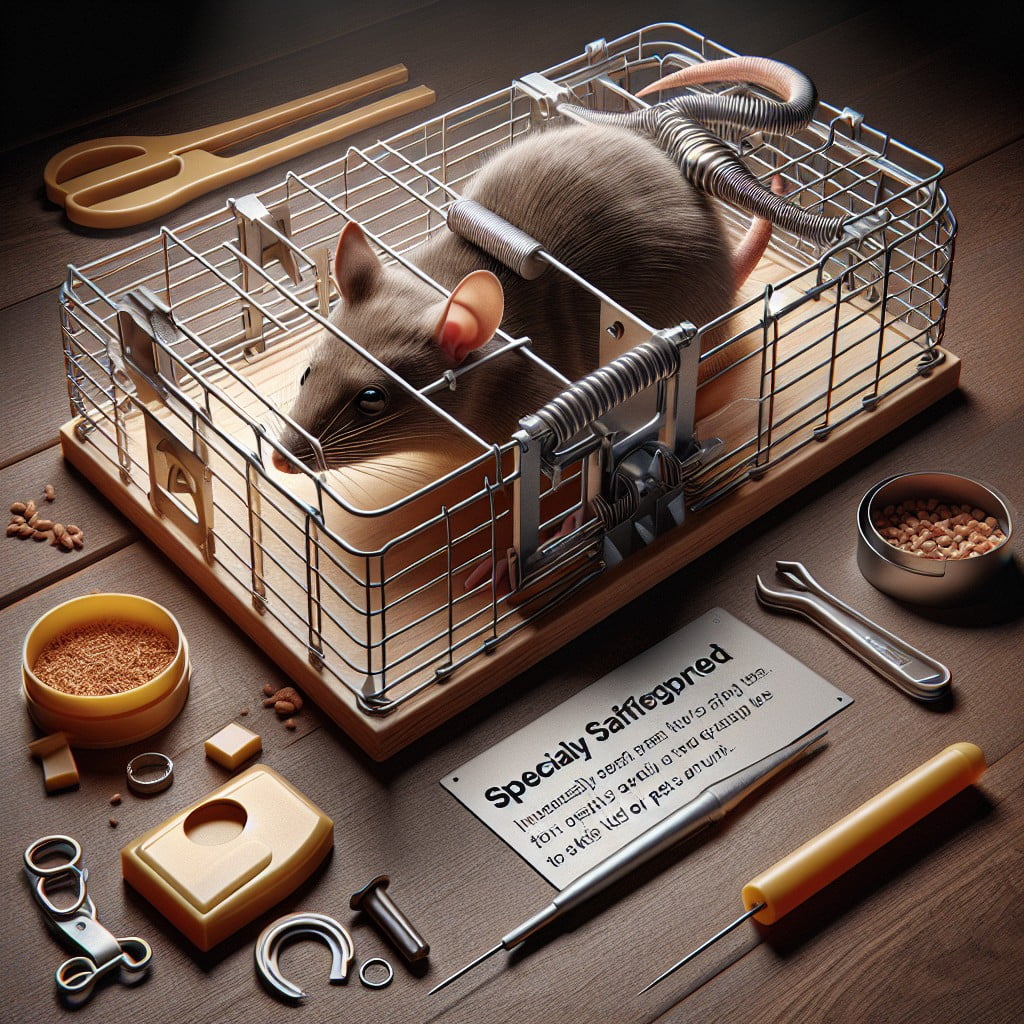Last updated on
Discover modern rat traps that professionally and humanely handle your rodent problem, because the efficiency and safety of these devices have evolved dramatically in recent years.
Navigating the maze of rat control can feel as challenging as outsmarting the rodents themselves. Whether you’re seeking a swift and humane solution, prioritizing safety around pets and children, managing costs, or addressing the problem without lethal force, finding the best rat trap for your specific needs is crucial.
From the no-nonsense efficacy of snap traps to the technologically advanced electric traps, and from budget-friendly to compassionate catch-and-release options, this guide zeroes in on the standout choices in the market. Dive into the details: explore designs that assure success, strategic placements that enhance efficacy, and construction quality that ensures durability. Get ready for a clear path to a rodent-free space.
Key takeaways:
- Snap trap is the top choice for swift and humane elimination.
- Electric trap is recommended for safety, preventing harm to non-targets.
- Budget pick offers cost-effective solution for effective results.
- Glue trap and live catch trap are non-lethal options for ethical considerations.
- Consider trap design, placement, and construction for optimal results.
Our Top Picks

The quest to banish rodents can feel daunting, but equipping yourself with the right trap turns the tide of battle. Our selections rise to the challenge; tailored to different needs, they ensure you can defend any space with confidence.
For swift, humane elimination, our top snap trap choice packs a powerful punch with precision. Its sensitivity and build quality make it a reliable frontline defense in high-traffic rodent areas.
Those with safety in mind will appreciate our recommended electric trap. It offers a quick solution and is designed to prevent unintended harm to non-targets, ideal for homes with curious pets or little ones.
For the cost-conscious, our budget pick proves you don’t need to spend big to get results. Simple yet effective, it’s a no-frills option that effectively deals with infestations without breaking the bank.
For those looking to avoid the mess or seeking a non-lethal method, our favorite glue trap and live catch trap options respect those preferences. They allow for catch-and-release or a no-touch disposal according to your ethical considerations or squeamishness.
Conclusively, different situations call for tailored solutions. Our selection strikes a balance between efficacy, safety, and value, ensuring your rat problem is met with an appropriate and effective response.
Buyers Guide

Selecting the right trap design is critical. Snap traps are popular for their effectiveness, while glue and electric traps offer alternatives for those seeking different methods. Consider the potential dangers to pets and children when choosing a trap, as some styles may pose a risk if accessed by curious hands or paws.
Placement location is key since rats typically traverse along walls. Traps should be set in these high-traffic areas to increase the chance of capture. Build quality is another factor, as durable materials like metal will generally outlast plastic counterparts and provide better value over time.
The method of capture is a personal choice; some prefer the quick action of snap traps, while others may opt for catch-and-release live traps, which are humane but require relocation of the live rat. Evaluate these aspects before making a purchase to ensure you select the most effective solution for your needs.
Consider the Trap Design

When choosing the most effective trap, it’s important to match the design with your situation. For instance, snap traps, known for their spring-loaded bars, deliver a quick, humane kill, and are ideal for those who do not wish to see or touch the rodents afterward. On the other hand, electronic traps deliver a high-voltage shock to instantly dispatch the pest and are suitable for tech-savvy users who prefer a clean method with minimal contact.
For a non-lethal approach, live-catch traps allow for the capture and release of the animal without harm, appealing to the humane conscious. Glue traps, while effective, can be distressing to deal with, as rodents are caught alive and must be disposed of while stuck to the adhesive pad.
The design also dictates the placement; certain traps work best in corners where rats typically travel, while others, like bait stations, can be placed along walls or in open spaces where rodents feed. By considering the design features, you ensure the trap works efficiently for your specific circumstance, leading to better control of these unwelcome guests.
Assess Pet and Child Safety

Understanding the potential hazards traps may pose to curious pets and children is crucial. Here are some safety considerations:
- Enclosed traps: Opt for designs that encase the trap mechanism to prevent accidental triggering by unintended victims.
- Trap placement: Position traps in areas less accessible to pets and children, such as behind appliances, upper shelves, or inside cabinets with child-proof locks.
- Non-toxic options: Choose traps that do not use poisons or chemicals, minimizing the risk of ingestion by pets or children.
- Regular monitoring: Check traps frequently to ensure they haven’t been tampered with and to quickly remove any trapped rodents.
- Inform the household: Teach family members, especially children, about the dangers of tampering with traps and emphasize the importance of informing an adult if a trap is found.
By prioritizing these points, you can minimize risks and create a safer environment while effectively managing rodent issues.
Choose a Trap Based On Placement Location
When determining where to place your rat trap, consider the architecture and traffic of the area. In bustling indoor spaces like garages or basements, snap traps or bait stations tucked away in corners can prevent accidental encounters with pets or children.
For outdoor use, weather-resistant traps are necessary, with electronic or heavy-duty snap traps being ideal. Living spaces may benefit from discreet, enclosed traps or electronic options that provide a quick and humane method of rodent control.
High-activity rat pathways, typically along walls or behind appliances, are prime locations for trap placement as rats tend to travel the same routes repeatedly. Remember, always position traps perpendicular to walls, with the trigger section facing the baseboard, to increase the chance of capturing these pests as they scurry by.
Consider Trap Construction
When selecting a rat trap, construction quality is a crucial factor that influences both the trap’s effectiveness and longevity. Durable materials such as heavy-duty plastic, galvanized steel, or resilient wood ensure that the trap can withstand the force of a rat’s capture and the outdoor elements if placed outside. A well-built trap will also have moving parts that operate smoothly and consistently, which is particularly important for snap traps where the precision of the mechanism can be the difference between a successful catch and a bait theft.
Paying attention to the fine details can enhance your trapping experience. For example, traps with fewer crevices make for easier cleaning, thus allowing for multiple uses. If you’re opting for an electronic trap, check the quality of the circuitry and housing to ensure it’s not only effective but also safe for use in your setting. Consider also the ease of setting the trap. Models that offer hands-free setting and disposal options reduce the risk of injury and contact with the rodents.
Remember, investing in a robustly constructed trap may come at a higher upfront cost but can save you money and time in the long run with fewer replacements and greater success in rat control.
Decide On Preferred Catch Method
When selecting a rat trap, consider how you want to handle the rodent once caught. Snap traps are a traditional choice, often resulting in the immediate demise of the rat. If you’re squeamish about the prospect of disposing of a dead rat, electronic traps might be for you, as they deliver a high-voltage shock to quickly kill the rodent, often with a disposal chamber for minimal contact.
Alternatively, if you prefer a humane approach, live-trap cages allow for the capture and subsequent release of the rat without harm. Glue traps, while effective, can be distressing for both the rat and the user, therefore require careful consideration before use.
Each method has its own set of protocols for baiting, setting, placement, and after-capture care, so choose the method that aligns with your level of comfort and desired involvement in the removal process.
How We Tested The Best Rat Traps
To provide comprehensive and reliable recommendations, a rigorous testing process was implemented. Each trap was evaluated on the following criteria:
- Effectiveness: The primary measure was the success rate in capturing rats. Traps were baited and placed in areas with known rat activity to monitor performance.
- Ease of Use: The setup process for each trap was timed and noted, with straightforward, quick-to-assemble options receiving higher marks.
- Durability: Over a set period, traps were exposed to various weather conditions to assess wear and tear resistance.
- Safety: Given the concern for non-target animals and humans, special attention was directed towards the safety mechanisms, ensuring that the risk of accidental injury was minimal.
- Disposal: The process of removing a captured rat and resetting or disposing of the trap was scrutinized to determine the convenience and contact level with the rodent.
- Cost Efficiency: The cost per trap and the long-term value were taken into account, especially in cases where multiple units might be needed.
Each trap’s performance was documented, and any outlier results were retested to ensure consistency and accuracy.
How to Get Rid of Rats in Your House: A Complete Guide [2023]
Eliminating rats from your home involves a strategic approach to ensure the rodents don’t return. Follow these key steps:
1. Inspect your home for entry points, such as gaps in the foundation, poorly sealed windows, and openings around pipes. Seal these entryways with materials that rats cannot chew through, such as steel wool or metal sheeting.
2. Maintain a clean environment. Store food in airtight containers and keep garbage in bins with tight-fitting lids. Regularly clean areas where food crumbs might accumulate, like kitchen counters and floors.
3. Remove clutter and potential nesting sites. Rats seek shelter in stacks of newspapers, boxes, and other undisturbed materials. Declutter your home to make it less appealing to rodents.
4. Set traps in high-activity areas. Look for droppings, gnaw marks, or greasy rub marks along baseboards to identify where rats frequent. Place the traps perpendicular to walls, with the trigger section facing the baseboard, to intercept rats as they run along these pathways.
5. Consider using baits such as peanut butter, bacon, or fruits as lures. Always wear gloves when handling baits and traps to prevent your scent from deterring the rats.
6. Regularly check and reset traps as needed, disposing of rodents according to local regulations. Continuous monitoring is crucial, as a single pair of rats can breed rapidly and create an infestation.
7. Support trapping efforts with natural repellents such as peppermint oil. Soak cotton balls in the oil and place them in areas of suspected rat activity. Note, this is a supplementary measure and should not replace physical traps.
Immediate action and persistence are key to effectively free your house from rats. Regular follow-through with these preventive practices will help ensure your living spaces remain rodent-free.
Best Overall
The Victor Metal Pedal Rat Trap stands out for its superior efficiency and affordability, making it a consensus pick for the best overall option. The classic metal pedal design is tried-and-true, known for its reliability in quickly eliminating rats with a powerful spring mechanism.
The trap is easy to set by hand or foot, and with its sturdy construction, it can be reused multiple times, offering long-term value. A bait cup ensures the placement of attractants is simple and targeted, a feature that improves catch rates. This model’s straightforward design also allows for easy disposal of rodents, minimizing the need for direct contact and maintaining hygiene.
Suitable for use in a variety of settings, from residential homes to commercial estates, its versatility further cements its top ranking.
Best Budget
For those looking to tackle a rat problem without putting a dent in their wallet, affordable yet effective solutions are available. The Victor Metal Pedal Rat Trap stands out for its cost-efficiency and simplicity. Its classic design has been trusted for over a century, featuring a spring-loaded mechanism that is straightforward to set up and reset. Additionally, this option allows for easy disposal of the rodent without the need to touch it directly, ensuring a hygienic process.
Another cost-conscious choice is the JT Eaton Jawz Plastic Rat Trap. This option incorporates a durable plastic construction that resists stains and odors, with a design that is easy to bait and set with a hand or foot for added safety. Both of these budget-friendly traps do not require the use of poisons, making them safer for use in homes with children or pets, although caution should always be exercised when placing traps.
It’s important to note that even with budget traps, strategic placement is key to success. Identifying high-traffic areas where rats are likely to travel or feed will maximize the effectiveness of these economical solutions.
Best Electric
Electric traps offer a quick and humane solution to a rodent problem, utilizing a high-voltage shock to eliminate rats efficiently. These traps are often favored for their ease of use and effectiveness.
When selecting the best electric model, you should consider the following:
- Battery Life: Most electric traps are battery-powered. Choosing a device with long battery life saves time and ensures continuous protection.
- Indication System: Look for traps with a notification system that alerts you when a rat has been caught. This can be in the form of a blinking light or a sound alarm.
- Safety Features: The best electric traps have built-in safety switches that deactivate the trap when the door is open, minimizing the risk of accidental shocks to humans or pets.
- Size: The size of the trap should be adequate to handle the size of the rats in your area. Some devices are designed for smaller rodents and may not be effective against larger rats.
- Disposal: Consider how you will dispose of the rodent after it has been caught. Traps with a ‘no-see, no-touch’ design allow for easy and hygienic disposal.
- Durability: Choose a trap made from durable materials that can withstand the elements, especially if you plan to use it outdoors.
By focusing on these factors, you increase your chances of selecting a highly efficient electric rat trap that meets your specific needs.
Best Pet-Friendly
Pet owners face unique challenges when contending with a rat problem. The safety of your furry friends is paramount, which is why opting for a pet-friendly trap is essential.
Certain designs cater to this need:
- Enclosed traps prevent curious paws or noses from getting close to the mechanism.
- Live catch traps offer a humane solution, allowing for release without harm to the animal or your pets.
- Some electronic traps are designed with safety features that deactivate when a larger mammal is nearby.
- Bait stations with tamper-resistant locks keep toxins away from pets while effectively eliminating rodents.
Always place traps in locations less accessible to pets and check them frequently to maintain both effectiveness and safety.
Trap Type: Snap-Back, Electric, Size, Material
Snap-back traps, often referred to as spring-loaded, are classic options that use a trigger plate and strong spring mechanism to quickly snap closed on an unsuspecting rat. These are typically made of wood or plastic and have a metal spring. They’re known for their effectiveness and simplicity, but they require careful handling to avoid snapping fingers.
Electric traps deliver a high-voltage shock to swiftly euthanize the rodent. Usually powered by batteries, these modern devices can be more humane, as they often result in instant death. They often feature indicator lights to signal a catch, making maintenance more straightforward.
Size is a practical concern when selecting a rat trap. It’s crucial to choose a trap that fits the size of the rodent you’re targeting. A trap too small may be ineffective, and one too large might not trigger properly for a smaller rat.
Material durability influences the longevity and reusability of a trap. Plastic, metal, and heavy-duty polymers are common materials that offer varying degrees of weather resistance for both indoor and outdoor use. Metal traps tend to last longer and can withstand the elements and the robust nature of rats.
Your Questions, Answered
Is bait included with rat traps?
Many rat traps come with bait or have a built-in bait cup to hold attractants. However, always check the product details, as some traps may require you to provide your own bait.
What are the best rat traps to use?
The effectiveness of a rat trap largely depends on the specific situation. For a single rat problem, snap traps may suffice, whereas severe infestations could benefit from electronic or multi-catch traps.
Where can you buy rat traps?
Rat traps are widely available in hardware stores, home improvement centers, and online retailers. You’ll find a variety of options on websites like Amazon, Home Depot, or Lowe’s.
Is Bait Included With Rat Traps?
Many rat traps come with pre-applied bait to simplify the setup process and increase the likelihood of capturing rats. For those that do not, manufacturers often provide a small starter pack of bait or recommend suitable bait types. Types of bait can include food-based attractants such as peanut butter, cheese, or meats, as these scents are highly appealing to rodents.
Some advanced traps might feature non-toxic bait that is safer to use around pets and children. Remember to check the packaging or product description to confirm whether bait is included or if you’ll need to purchase it separately. If you’re replenishing bait, always adhere to the trap’s guidelines for the best results in rodent control.
What Are the Best Rat Traps to Use?
When selecting the ideal trap for your rat problem, efficacy and safety take priority. Snap traps, known for their simplicity and effectiveness, quickly dispatch rodents with a metal bar. Electric traps deliver a high-voltage shock, ensuring a humane kill with minimal mess. Glue traps, while a non-toxic option, can be challenging due to their inhumane nature and potential mess.
Live catch traps offer a no-kill solution, allowing for the release of the rat elsewhere, ideal for those preferring a humane approach. Bait stations, designed more for prevention, keep poisons contained to target only rodents, reducing the risk to non-target animals and children. Consider these types of traps in light of your specific situation — whether indoors or outdoors, the level of infestation, and personal preferences for humane treatment.
Evaluating these factors will guide you to the most appropriate and effective rat control solution.
Where Can You Buy Rat Traps?
Rat traps are widely available at various retailers. Hardware stores are a reliable source; they typically offer a range of options along with expert advice.
Home improvement centers likewise stock an assortment of traps and may provide demonstrations or guidance on usage.
For convenience and price comparison, online marketplaces such as Amazon feature a vast selection, complete with user reviews to aid decision-making.
Garden supply stores and pest control specialty shops focus on traps that are environmentally friendly and designed for outdoor use.
Lastly, supermarkets and general stores often carry basic models suitable for quick solutions.
Remember to check the availability of different types of traps at these locations to ensure you find the one best suited to your needs.
Best Glue Trap
Glue traps, often chosen for their simplicity and discretion, capture rodents on a sticky surface, preventing them from escaping. Ideal for light infestations, they are easy to set and can be placed in tight areas where traditional traps may not fit.
When opting for glue traps, it’s important to check them regularly to ensure humane treatment of the trapped rodent and to dispose of them properly. Additionally, they are non-toxic, making them a safer option around children and pets, though you should still place them out of reach.
Keep in mind, effectiveness can vary depending on environmental conditions; extreme temperatures can affect the adhesive, so they’re best used indoors.
FAQ
Which rat traps are most effective?
The most effective rat traps are the Rat Zapper Classic Indoor Electronic Mouse and Rat Trap, renowned for its reusability, concealed design, and alert system for emptying; as a more economical choice, the Victor Rat Traps proficiently trap the rodent and are disposable post-use.
What is the most successful way to get rid of rats?
The most effective way to eliminate rats is to strategically position snap traps in high-activity areas such as along walls, behind appliances, or under furniture, as they provide a swift and humane solution at an affordable cost.
What is the best rat trap style?
The best rat trap style is a plastic or metal cage trap due to its weatherproof nature, adjustable size, and a more humane method of rodent prevention.
Why is the rat not getting caught in trap?
The rat may not be getting caught in the trap due to errors such as utilizing inappropriate bait, prematurely setting the trap, overlooking potential hiding spots or entry points, and inadvertently making the attic a welcoming habitat for pests.
How does bait choice affect the success of a rat trap?
The choice of bait significantly affects the success of a rat trap as rats are primarily attracted to foods high in protein and fat, such as peanut butter or bacon, thereby increasing the likelihood of ensnaring them.
What is the significance of trap placement in effectively catching rats?
Effective rat trapping significantly hinges on trap placement, specifically in low-traffic areas near walls or corners, where these creatures frequently travel, to optimally exploit their natural behavior and tendency towards new objects in their environment.
What safety precautions should be considered when using rat traps?
When using rat traps, it’s essential to wear gloves for sanitary protection, place the traps out of reach of children and pets, and handle the traps cautiously to prevent injury.
Recap:




